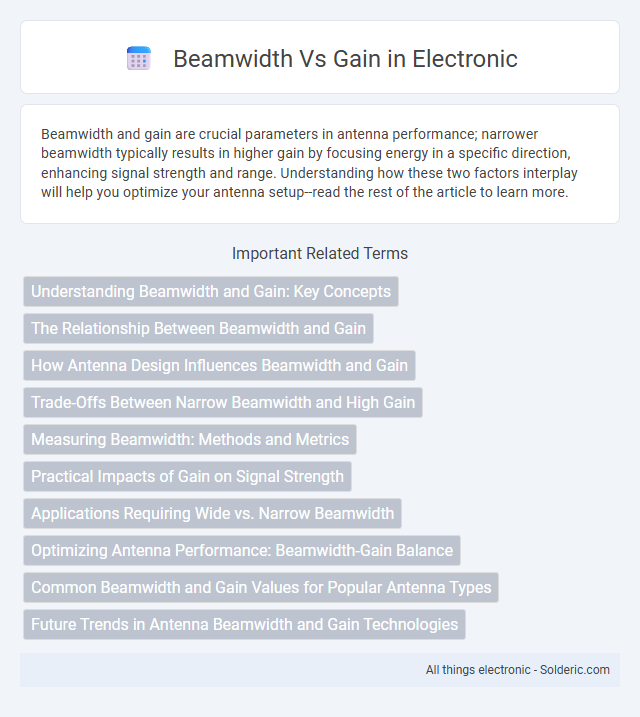Beamwidth and gain are crucial parameters in antenna performance; narrower beamwidth typically results in higher gain by focusing energy in a specific direction, enhancing signal strength and range. Understanding how these two factors interplay will help you optimize your antenna setup--read the rest of the article to learn more.
Comparison Table
| Parameter | Beamwidth | Gain |
|---|---|---|
| Definition | The angular width of the main lobe of an antenna's radiation pattern, usually measured at the half-power (-3 dB) points. | The measure of antenna's ability to direct radio energy in a specific direction, expressed in decibels (dBi or dBd). |
| Unit | Degrees (deg) | Decibels (dBi or dBd) |
| Relation | Inverse relationship with Gain; narrower beamwidth generally means higher gain. | Directly affected by beamwidth; higher gain corresponds to narrower beamwidth. |
| Impact | Determines the antenna's coverage area and directionality. | Indicates the increase in signal strength in the favored direction. |
| Application | Used to define angular resolution and coverage in antennas and arrays. | Used to evaluate antenna efficiency and strength of signal transmission/reception. |
Understanding Beamwidth and Gain: Key Concepts
Beamwidth and gain are critical parameters in antenna performance, with beamwidth defining the angular width of the main lobe where signal strength remains strong, and gain quantifying the antenna's ability to focus energy in a specific direction. A narrower beamwidth typically results in higher gain, enhancing signal quality and range by concentrating energy more effectively. Understanding these concepts helps you optimize antenna selection and placement for improved communication efficiency.
The Relationship Between Beamwidth and Gain
Beamwidth and gain are inversely related in antenna design, where a narrower beamwidth results in higher gain by concentrating energy in a specific direction. This concentrated radiation pattern enhances signal strength and range, improving the effectiveness of your communication system. Understanding this relationship helps optimize antenna performance for targeted applications.
How Antenna Design Influences Beamwidth and Gain
Antenna design directly impacts beamwidth and gain by shaping the radiation pattern and energy concentration. Narrow beamwidth antennas, such as parabolic dishes, achieve higher gain by focusing energy into a smaller angular region, enhancing signal strength and directionality. Conversely, antennas with wider beamwidths distribute energy over a larger area, resulting in lower gain but broader coverage.
Trade-Offs Between Narrow Beamwidth and High Gain
Narrow beamwidth antennas deliver high gain by concentrating energy into a tight radiation pattern, enhancing signal strength and range. However, this focused coverage reduces spatial flexibility, requiring precise alignment to maintain optimal communication. Your choice balances between achieving maximum gain and maintaining adaptable coverage depending on application needs.
Measuring Beamwidth: Methods and Metrics
Measuring beamwidth involves using methods such as the half-power (-3 dB) beamwidth metric, which defines the angular width where the antenna's power drops to half its maximum gain. Techniques include planar near-field scanning, which maps radiation patterns in controlled environments, and far-field measurements that utilize angular rotation of the antenna to capture gain variations. Accurate beamwidth measurements are critical for optimizing antenna gain, as narrower beamwidths typically correspond to higher directional gain, affecting antenna performance in applications like radar and wireless communications.
Practical Impacts of Gain on Signal Strength
Higher gain antennas concentrate energy into narrower beamwidths, significantly enhancing signal strength and range in targeted directions. This focused energy improves communication reliability, reduces interference, and maximizes the efficiency of your wireless system. Understanding the trade-off between beamwidth and gain is vital for optimizing antenna performance in practical applications.
Applications Requiring Wide vs. Narrow Beamwidth
Applications requiring wide beamwidth benefit from broad signal coverage, ideal for radar systems scanning large areas or Wi-Fi routers providing consistent connectivity across open spaces. Conversely, narrow beamwidth is essential for applications demanding high gain and precise targeting, such as satellite communications, point-to-point microwave links, and directional antennas in 5G networks. Your choice between wide and narrow beamwidth directly influences system performance by balancing coverage area with signal strength and focus.
Optimizing Antenna Performance: Beamwidth-Gain Balance
Optimizing antenna performance requires balancing beamwidth and gain to achieve efficient signal transmission and reception. Narrow beamwidth enhances gain by concentrating energy in a specific direction, improving signal strength and reducing interference. Your antenna choice should consider this trade-off to ensure reliable communication tailored to your coverage and range needs.
Common Beamwidth and Gain Values for Popular Antenna Types
Common beamwidth and gain values vary significantly across popular antenna types, with Yagi antennas typically offering a narrow beamwidth of 40-60 degrees and gains ranging from 8 to 15 dBi, ideal for directional communication. Parabolic dish antennas achieve very narrow beamwidths below 10 degrees while providing high gains often exceeding 30 dBi, making them suitable for long-distance point-to-point links. Your choice depends on the balance between beamwidth and gain required for your specific application, with omnidirectional antennas featuring wide beamwidths around 360 degrees but lower gains near 2-5 dBi for broad area coverage.
Future Trends in Antenna Beamwidth and Gain Technologies
Future trends in antenna beamwidth and gain technologies emphasize the integration of advanced materials like metamaterials and graphene to achieve ultra-narrow beamwidths with exceptionally high gain for improved spatial resolution. Adaptive beamforming algorithms combined with AI-driven signal processing optimize dynamic beamwidth adjustment, enhancing communication efficiency in 5G and beyond networks. Emerging phased array systems leverage miniaturization and massive MIMO configurations, pushing the boundaries of gain while maintaining precise beam control for next-generation wireless applications.
beamwidth vs gain Infographic

 solderic.com
solderic.com